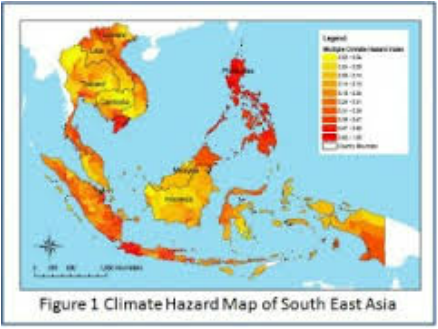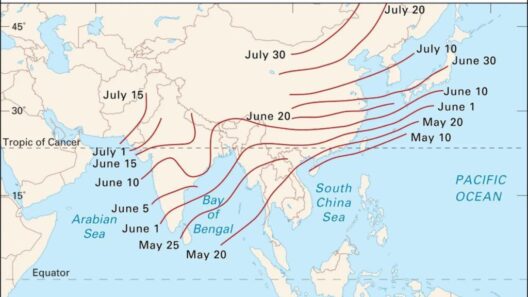The climate of Indonesia is a multifaceted tapestry woven from equatorial heat and tropical rain, creating an environment that is both vibrant and complex. Nestled on the equator, Indonesia’s climate is characterized by high humidity, warm temperatures, and significant rainfall throughout the year. Each of these factors contributes to the burgeoning ecosystems and diverse habitats that encapsulate the archipelago, creating a unique climatic phenomenon that deserves exploration.
One of the most striking aspects of Indonesia’s climate is its equatorial heat. This equatorial belt is known for its consistently high temperatures, typically ranging from 25°C to 35°C (77°F to 95°F). The proximity to the equator results in minimal variation in temperature throughout the seasons, unlike regions further from this imaginary line where seasonal temperature swings are pronounced. The equatorial sun bathes Indonesia in its rays, fostering a climate that is both warm and stimulating for an array of flora and fauna.
The warm temperatures are exacerbated by the high humidity levels. Indonesia experiences humidity levels averaging between 70% to 90%, further intensifying the perception of heat. This humidity is primarily due to the prevalence of bodies of water, including vast oceans, rivers, and swamps, that saturate the air with moisture. The combination of heat and humidity creates a conducive environment for the rich biodiversity that thrives in Indonesian rainforests and coastal regions. Such ecosystems are home to thousands of species, some of which are found nowhere else on Earth, flourishing in their specialized habitats.
However, understanding Indonesia’s climate cannot be complete without delving into the intricate patterns of tropical rain. Indonesia experiences a wet season and a dry season, although the distinction may not always be clearly defined due to regional variations. The wet season typically occurs from November to March, where rainfall is at its peak. During this season, monsoonal winds converge upon the archipelago, delivering heavy downpours that can lead to waterlogged landscapes and flash floods, especially in low-lying areas.
Conversely, the dry season extends from April to October, during which rainfall diminishes significantly, particularly in regions such as Bali and parts of Sumatra. Despite being labeled the dry season, intermittent showers can still occur, especially on the eastern islands, owing to their geographic diversity and varied topography. This complex interplay of wet and dry conditions contributes to the intricate hydrology that defines the region, influencing agriculture, water availability, and even human settlement patterns.
The climatic phenomena affecting Indonesia can further be influenced by larger atmospheric patterns, such as El Niño and La Niña. El Niño events are generally associated with drier conditions and occasional drought, while La Niña tends to bring about increased rainfall and can lead to more severe flooding. Such events underscore the fragility of Indonesia’s climatic balance and the susceptibility of its ecosystems and inhabitants to climate variability and extremes.
Climate change exacerbates these intrinsic climatic characteristics, posing significant risks to the environment and the communities that depend on it. Rising global temperatures are intensifying weather patterns, leading to unpredictable rainfall and increased occurrences of natural disasters such as floods and landslides. This can devastate the agricultural sector, which is vital to Indonesia’s economy and food security. Moreover, indigenous wildlife, adapted to specific weather patterns, also face existential threats as their habitats become altered or diminished.
On the other side, the lush jungles of Indonesia act as a critical carbon sink, sequestering atmospheric CO2 and mitigating climate change. Protecting these forests and their inhabitants is not merely an environmental concern; it is an imperative for global health. Yet, rampant deforestation, driven by agricultural expansion, logging, and mining, erodes this crucial resource. The balance of preserving biodiversity while fostering economic growth remains a challenge that Indonesia must address.
Furthermore, rising sea levels due to climate change pose a threat to Indonesia’s extensive coastline, putting coastal communities at risk of inundation. Islands such as Jakarta, which is already sinking due to groundwater extraction, face a dystopian future if effective mitigating strategies are not employed. Coastal erosion and habitat loss for both human populations and wildlife are urgent concerns that require immediate action.
In transitioning to a more sustainable model of living, there lies the potential for Indonesia to shift its narrative. The archipelago is rich in renewable resources—from solar power to geothermal energy—that can be harnessed to combat climate change. Development programs focusing on sustainable practices in agriculture, energy production, and tourism can serve both the economy and the environment while fostering resilience against climate impacts.
Indonesia’s climate, with its equatorial heat and tropical rains, is a prime example of nature’s complexity and beauty. The intricate interplay of global atmospheric patterns and local weather systems creates a dynamic environment that is precariously balanced on the brink of change. As climate change poses unprecedented challenges, a dual approach of conservation and innovation is imperative. Only then can Indonesia, with its remarkable natural wealth and cultural heritage, continue to thrive under the ever-watchful eye of the equatorial sun.
Through understanding and engagement, there exists the promise that a shift in perspective can lead to a richer appreciation for Indonesia’s climate and its vital role in the global ecosystem. Thus, curiosity should not merely be piqued; it must be ignited into action, spurring reforms aimed at preserving the environment for future generations.







